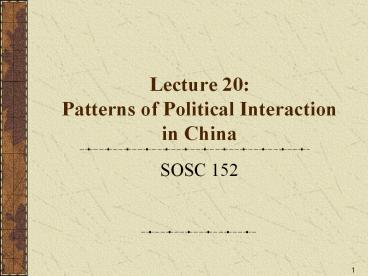Lecture 20: Patterns of Political Interaction in China - PowerPoint PPT Presentation
1 / 17
Title: Lecture 20: Patterns of Political Interaction in China
1
Lecture 20 Patterns of Political Interaction in
China
- SOSC 152
2
- A. Can we talk of "participation" in socialist
systems? - B. Modes of participation?
3
A. Can we talk of "participation" in socialist
systems?
- 1. Definition "Conscious effort by individuals
or groups to influence the actions of rulers,
change their rulers, or affect policy outcomes at
all levels of the political system." - clearly participation does occur but usually not
approved by rulers - party sees all group efforts outside its control
as illegitimate - party role is to direct social change, not
respond to social demands - Today, the party really wants to limit
participation, not mobilize it
4
A. Can we talk of "participation" in socialist
systems? (cont)
- 2. Mobilized (??) versus Autonomous (??)
Participation - need to differentiate these two types, former
really state directed. - party organizes citizens into mass organizations
to prevent autonomous participation - mass mobilization as strategy for party to fill
up political space - "instrumental" view of participation, supported
if it helps economy, but if it threatens party
control great pressure to stop it.
5
A. Can we talk of "participation" in socialist
systems? (cont)
- 3. CCPs traditional concept of participation
The Mass Line (????) - "from the masses to the leaders, from the leaders
to the masses" - party collects information from people, turns it
into policy, takes it back to the people - in open periods quite effective, in conservative
periods or during mass mobilization party leaders
don't listen.
6
A. Can we talk of "participation" in socialist
systems? (cont)
- 4. Reform and Participation
- under Russia and China, reformers gave groups
more autonomy as way to generate popular support,
initiative, and resolve social problems - Zhao Ziyang's willingness in 1987 to recognize
societal interests - by fall 1988, conservatives attacked this
concept, fearful of societal demands - See handout on Interest Groups Under Socialism
7
Different Interest Groups Under Socialism
8
Controlling the Diversification of Interests
9
Sino-Soviet Summit Anticipated in 1989
10
B. Modes of Participation
- 1. Elections
- a. Rural Elections
- most early elections in 1960s and 1970s were for
team leader (????) under collective system - party tries to control who runs for office
- elections for village leaders in 1980-81, let
village leaders (????) express displeasure with
local leaders - now since 1988, electing Villagers Committee
(?????) and their leaders in villages in China
under design of Ministry of Civil Affairs (???)
to get farmers to invest in rural projects, bring
stability. - great variation in these elections in openness,
level of campaigning, secret ballot - Party usually controlled candidates until Hai
Xuan (??) - 1999 Law allowed open nominations
11
B. Modes of Participation (cont)
- b. Elections for Provincial People's Congress
- in 1980, after Deng speech supporting democracy,
very open elections - some candidates elected ran on anti-party
platform Haidian district (???) - though elected, not allowed to take office
- elections in 1986 were open in some cities, party
suppressed them, students in Hefei, Shanghai,
Beijing, took to streets in protest, led to fall
of Hu Yaobang.
12
Participation in Election-related activities in
Four counties in Rural China, 1999
13
B. Modes of Participation (cont)
- c. Group Activity
- according to definition, need "conscious
awareness of shared interests," autonomous
leaders, medium through which to communicate
ideas, and channels to leaders - under socialist systems, formal interest groups
not allowed to form, but NGO (Non-governmental
organizations) beginning - but participation can occur through formal
organizations, if party let them. - still very different from interest groups in
democratic systems - in fall, 1986, managers of factories were
organized by reformers to discuss attitudes
towards political reform
14
B. Modes of Participation (cont)
- c. Group Activity (cont)
- students efforts to have Autonomous Student
Federation (???) during spring 1989, strongly
resisted by many top party leaders - fearful that it would legitimize Workers Unions
(???). - in USSR, scientists protested to save Lake
Baikal, first environmental movement - Today in China many protests over environment
- Group petitions to higher level officials (????)
15
B. Modes of Participation (cont)
- d. Collective Action
- 1. Protest marches not uncommon in 1980s
- Tiananmen (1989) as largest scale protests
against party since 1949. - Falun Gong (???)
- 2. "Unorganized Collective Action"
- many people share similar constraints and efforts
by them all to break out at same time - rural reform followed this pattern, as peasants
throughout country pushed for decollectivization - critique of party during before Anti-Rightist
Campaign
16
B. Modes of Participation (cont)
- d. Collective Action (cont)
- 3. Widescale passive resistance
- in 1973 during Pi-Lin Pi-Kong Campaign (??????),
workers slowed down to protest poor working
conditions - slowdown by bus drivers in Beijing in 1986 to
protest taxi driver salaries - 4. Individual Activity
- because many allocations of resources and
opportunities are political, scope of politics
wider in socialist systems - Voting in village elections
- individual efforts to get benefits becomes
political, approaching cadres - Join the system, the Party, participatory in
campaigns - various strategies include letters to newspapers,
big character posters (???) to State Council
Office, taking official to court Administrative
Law (???) in 1990
17
Strategies employed by villagers to solve
problems in four counties in rural China, 1999































